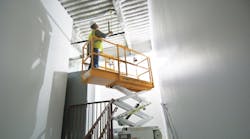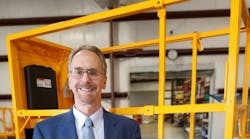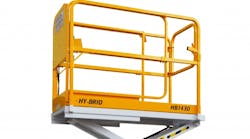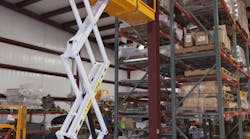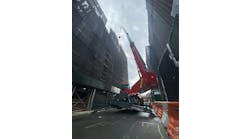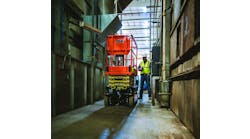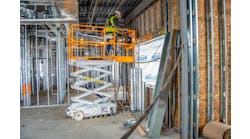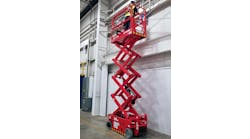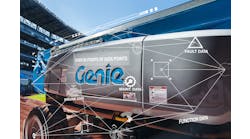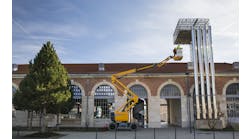RER interviews Justin Kissinger, marketing manager, Custom Equipment, about how interest in safety, ergonomics and fuel efficiency is continuing to drive growth in the electric scissorlift market.
RER: What new technological developments are on the horizon for you?
Kissinger: We work closely with our customers to develop ways we can help them be more efficient, productive and safe, from adding long-lasting AGM batteries and electrical drive and steering systems to ensuring high platform capacities. We’re continuing to work closely with contractors to develop new solutions for their challenges and drive scissor lift innovation.
In general, what trends do you see coming up in aerial equipment?
Kissinger: Safety continues to play a big role in the construction industry, especially when it comes to ladder and scaffold usage. This is why we continue to see growth in the low level access lift market. Every contractor has tools and supplies he or she must handle when working, whether it’s at 2 feet or 20 feet. While ladders allow contractors to reach those higher projects, it puts them at risk for serious injuries from falls. Even scaffolds come with a high risk of falls. They offer a platform from which to work, but workers still must climb up and down the system with tools and materials in tow, which isn’t necessarily safe or ergonomic. Electric scissor lifts, on the other hand, provide a secure space for contractors to move up and down with their equipment and materials to safely complete the job without strain. Falls are one of the biggest OSHA citations, and electric scissor lifts are countering that statistic. It is something contractors are really looking for, not only for safety, but efficiency, too.
What new safety developments and safeguards have you made on your equipment?
Kissinger: One of the latest features we’ve worked closely with a customer to develop is a pipe rack that helps workers safely transport materials from the ground to the ceiling for installation. We designed the rack to give the contractor an easy and efficient way to haul more materials to elevated workspaces, and now offer this solution to help other HVAC and plumbing contractors be more productive.
In addition to the pipe rack development we’ve also started to include a tool tray on all of our self-propelled lifts. The tray enhances ergonomics. Users can easily reach tools rather than bend down to pick up materials from the scissor lift deck. We’ve also included a USB port that’s built into the upper control so users can charge electronic devices, such as phones and tablets, on the go. This combination of features helps worker productivity and enhances communication.
Any new developments in training?
Kissinger: Safety is the number one priority on every jobsite and we’re always looking for ways we can enhance that, both through the designs of our low-level scissor lifts and through industry associations, such as the Occupational Safety and Health Administration.
In general, what are your expectations for the aerial market in the foreseeable future, in North America and internationally?
Kissinger: I believe we will continue to see safety play a bigger and bigger role, particularly when it comes to ladder and scaffold usage. The new ANSI/CSA changes will make standards more similar across the board as well. In turn this will likely boost aerial lift sales. One of the biggest challenges we see is the difficulty contractors have in justifying the need and price of scissor lifts, whether they are renting or buying. Ladders are inexpensive and easily accessible; most contractors have plenty on hand they can grab and go. But contractors must also consider the costs associated with just one worker’s compensation claim. The risk of falls from ladders and scaffolding is high and so are the costs associated with a claim, which averages $98,000 in medical care and lost wages per person. Safety is one of the hallmarks of our business and we will continue to educate the market on the risks associated with ladders and scaffolding as well as how our Hy-Brid Lifts offer an alternative that’s not only safer but also more efficient and productive.
